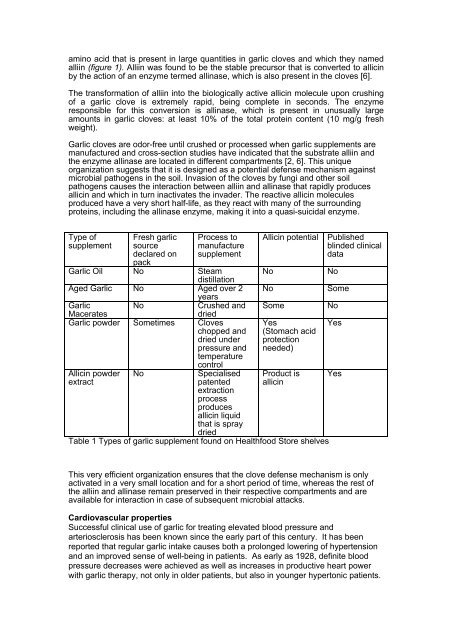Allicin from Fresh Garlic - Stabilized Allicin Products
Allicin from Fresh Garlic - Stabilized Allicin Products
Allicin from Fresh Garlic - Stabilized Allicin Products
You also want an ePaper? Increase the reach of your titles
YUMPU automatically turns print PDFs into web optimized ePapers that Google loves.
amino acid that is present in large quantities in garlic cloves and which they named<br />
alliin (figure 1). Alliin was found to be the stable precursor that is converted to allicin<br />
by the action of an enzyme termed allinase, which is also present in the cloves [6].<br />
The transformation of alliin into the biologically active allicin molecule upon crushing<br />
of a garlic clove is extremely rapid, being complete in seconds. The enzyme<br />
responsible for this conversion is allinase, which is present in unusually large<br />
amounts in garlic cloves: at least 10% of the total protein content (10 mg/g fresh<br />
weight).<br />
<strong>Garlic</strong> cloves are odor-free until crushed or processed when garlic supplements are<br />
manufactured and cross-section studies have indicated that the substrate alliin and<br />
the enzyme allinase are located in different compartments [2, 6]. This unique<br />
organization suggests that it is designed as a potential defense mechanism against<br />
microbial pathogens in the soil. Invasion of the cloves by fungi and other soil<br />
pathogens causes the interaction between alliin and allinase that rapidly produces<br />
allicin and which in turn inactivates the invader. The reactive allicin molecules<br />
produced have a very short half-life, as they react with many of the surrounding<br />
proteins, including the allinase enzyme, making it into a quasi-suicidal enzyme.<br />
Type of<br />
supplement<br />
<strong>Fresh</strong> garlic<br />
source<br />
declared on<br />
pack<br />
Process to<br />
manufacture<br />
supplement<br />
<strong>Allicin</strong> potential Published<br />
blinded clinical<br />
data<br />
<strong>Garlic</strong> Oil No Steam<br />
distillation<br />
No No<br />
Aged <strong>Garlic</strong> No Aged over 2<br />
years<br />
No Some<br />
<strong>Garlic</strong><br />
No Crushed and Some No<br />
Macerates<br />
dried<br />
<strong>Garlic</strong> powder Sometimes Cloves Yes<br />
Yes<br />
chopped and (Stomach acid<br />
dried under protection<br />
pressure and<br />
temperature<br />
control<br />
needed)<br />
<strong>Allicin</strong> powder No Specialised Product is Yes<br />
extract<br />
patented<br />
extraction<br />
process<br />
produces<br />
allicin liquid<br />
that is spray<br />
dried<br />
allicin<br />
Table 1 Types of garlic supplement found on Healthfood Store shelves<br />
This very efficient organization ensures that the clove defense mechanism is only<br />
activated in a very small location and for a short period of time, whereas the rest of<br />
the alliin and allinase remain preserved in their respective compartments and are<br />
available for interaction in case of subsequent microbial attacks.<br />
Cardiovascular properties<br />
Successful clinical use of garlic for treating elevated blood pressure and<br />
arteriosclerosis has been known since the early part of this century. It has been<br />
reported that regular garlic intake causes both a prolonged lowering of hypertension<br />
and an improved sense of well-being in patients. As early as 1928, definite blood<br />
pressure decreases were achieved as well as increases in productive heart power<br />
with garlic therapy, not only in older patients, but also in younger hypertonic patients.


